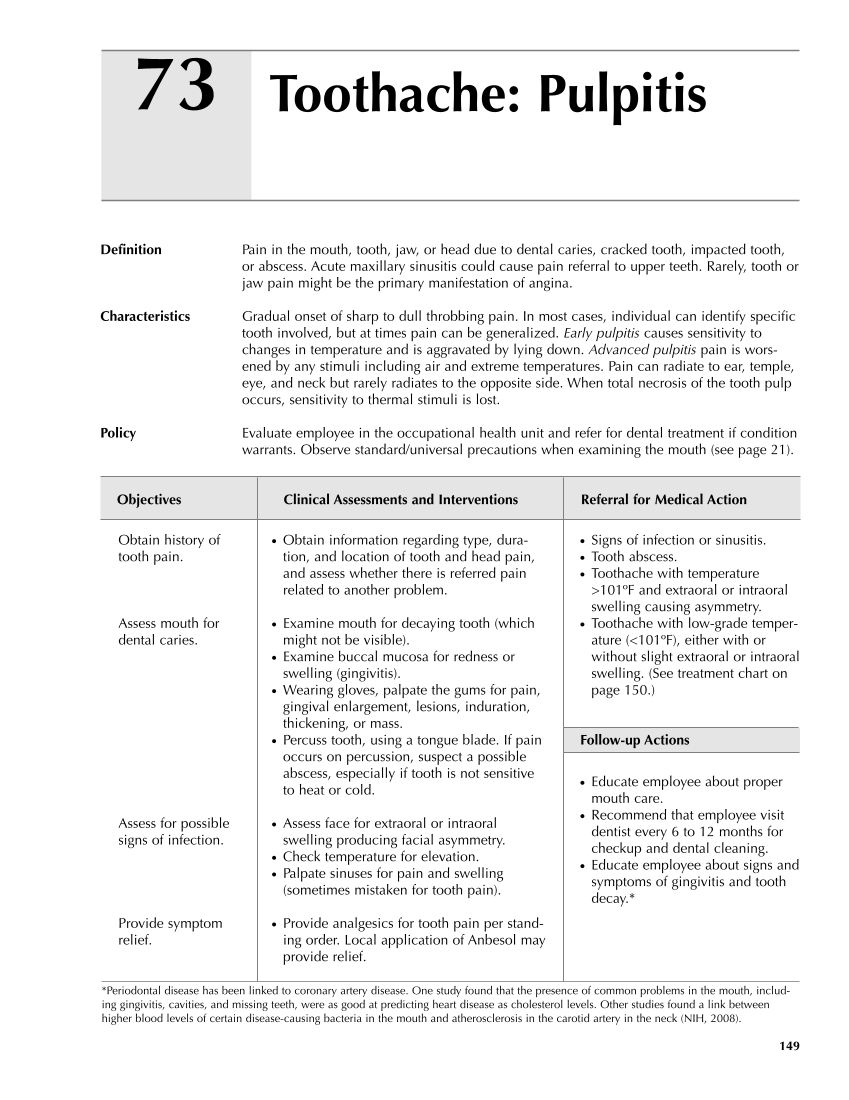149 Toothache: Pulpitis 73 Definition Pain in the mouth, tooth, jaw, or head due to dental caries, cracked tooth, impacted tooth, or abscess. Acute maxillary sinusitis could cause pain referral to upper teeth. Rarely, tooth or jaw pain might be the primary manifestation of angina. Characteristics Gradual onset of sharp to dull throbbing pain. In most cases, individual can identify specific tooth involved, but at times pain can be generalized. Early pulpitis causes sensitivity to changes in temperature and is aggravated by lying down. Advanced pulpitis pain is wors- ened by any stimuli including air and extreme temperatures. Pain can radiate to ear, temple, eye, and neck but rarely radiates to the opposite side. When total necrosis of the tooth pulp occurs, sensitivity to thermal stimuli is lost. Policy Evaluate employee in the occupational health unit and refer for dental treatment if condition warrants. Observe standard/universal precautions when examining the mouth (see page 21). Objectives Clinical Assessments and Interventions Referral for Medical Action ● Signs of infection or sinusitis. ● Tooth abscess. ● Toothache with temperature 101ºF and extraoral or intraoral swelling causing asymmetry. ● Toothache with low-grade temper- ature (101ºF), either with or without slight extraoral or intraoral swelling. (See treatment chart on page 150.) Follow-up Actions ● Educate employee about proper mouth care. ● Recommend that employee visit dentist every 6 to 12 months for checkup and dental cleaning. ● Educate employee about signs and symptoms of gingivitis and tooth decay.* Obtain history of tooth pain. Assess mouth for dental caries. Assess for possible signs of infection. Provide symptom relief. ● Obtain information regarding type, dura- tion, and location of tooth and head pain, and assess whether there is referred pain related to another problem. ● Examine mouth for decaying tooth (which might not be visible). ● Examine buccal mucosa for redness or swelling (gingivitis). ● Wearing gloves, palpate the gums for pain, gingival enlargement, lesions, induration, thickening, or mass. ● Percuss tooth, using a tongue blade. If pain occurs on percussion, suspect a possible abscess, especially if tooth is not sensitive to heat or cold. ● Assess face for extraoral or intraoral swelling producing facial asymmetry. ● Check temperature for elevation. ● Palpate sinuses for pain and swelling (sometimes mistaken for tooth pain). ● Provide analgesics for tooth pain per stand- ing order. Local application of Anbesol may provide relief. *Periodontal disease has been linked to coronary artery disease. One study found that the presence of common problems in the mouth, includ- ing gingivitis, cavities, and missing teeth, were as good at predicting heart disease as cholesterol levels. Other studies found a link between higher blood levels of certain disease-causing bacteria in the mouth and atherosclerosis in the carotid artery in the neck (NIH, 2008).
Purchased from OEM Press by (ge corporate access). (C) 2013 OEM Health Information, Inc. All rights reserved.












































































































































































































































































































































































































































